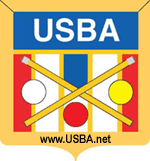“I CAN'T DO anything with this!” Time and time again, the endlessly fertile game of three-cushion billiards will present you with
a shot that seems doomed no matter what you do. Shots which seem impossible to score introduce themselves to every player at every
level; how the Better players determine their approaches to such shots depends on their knowledge of the correct concept of the modern
billiard game. It's a matter of a little imagination and a lot of common sense; apply both and you'll soon be enjoying the glow of
scoring a point or two that feel like they should be worth twelve.
Frequently, shots are seemingly unmake able because of the angle between the cue ball and first object ball; you may be cut off from the angle you'd normally use to score naturally and, confronted with the problem of even coming close to scoring, you may well not think about position play at all. Which, as we’ll see in two of these apparently tough shots, would be a mistake? It is true that, unlike previous articles, not all these examples focus on position play. They're extreme, and not-so-extreme, examples of difficult positions that arise with some frequency.
The shots of Diagrams 1 and 2 can indeed be utilized for position as well as to score; Diagrams 3 and 4 shows you more extreme shots, which you can execute with confidence by using a cute little system I, figured out about 25 years ago, it’s really simple, why not, the game itself is difficult enough.
In Diagram 1, the cue ball and first object ball are only one to two inches apart; the angle between them is such that you can't go five rails around the table off the left side of the ball, nor can you go four cushions around the table off the other side of the ball (your hit on the first ball would bring you in way short). More than anything else, this is a balk line-type shot that requires a surgeon's touch and precision - but you can still make the most of a bad position. It's critical that you use a very short fist or nip bridge, in order to hit the cue ball with maximum 6 o'clock English. The reason for that low bridge is to get as low on the cue ball as possible yet avoid elevating the butt of your cue; on this shot, you need quick draw action, and you can't get that with an elevated cue. Hit the object ball one-third full, with a short stroke and a soft touch. Properly executed, with just enough cue-ball speed to score, this shot will yield excellent position with all three balls fairly close to the top rail.
Diagram 1
The shot in Diagram 2 is not only rarely played, but rarely conceived by the average player. Typically, such a player would merely throw up his hands; the angle between cue ball and first ball does not permit going around the table in the natural way, nor can the shot be played with reverse English into the opposite rail which turns into running English off the next three. Again, the cue ball and first object ball are very close together, half an inch to one inch. Here you do need to elevate the cue slightly; that will put a little curve on the ball off the first cushion in order to maintain the extreme 4 o'clock English you must use. Your objective, as shown, is to strike the short rail close enough to the corner that you reverse that rail and return to the red in the comer. A normal bridge will add some speed to the stroke, in order to achieve that maximum English and maintain it through the four rails. Hit the object ball very thin, so as not to drive it too far away from your intended position along the rail. Again, your speed should be such that you just score, and all three balls should end up along that long rail.
Diagram 2
In Diagram 3, the cue ball's position is somewhat unique in that it's only about an inch from the first cushion we're going to contact. This shot repre-sents the new system I have to share with you. What we do first here is to locate our cue-ball position in relationship to a 45-degree angle — the dotted line — from the first cushion we're to hit and back through the cue ball to the long cushion.
Once we've established that, we can estimate what English to put on the cue ball, according to the contact point on the third rail. In the position shown in the diagram, the cue ball is two diamonds from the side rail; 6 o'clock English will take us exactly twice that far, or diamond 4, just what we need to go rail-first off the white ball. This shot requires maximum 6 o'clock English and a medium-soft stroke.
To go farther down the rail than that, add one tip of reverse English for every two diamonds you want to add. Thus if the cue ball were three diamonds from the long rail instead of two, and the object balls were as you see them, 6 o'clock English would take you too far down the rail; you'd use 5 o'clock instead. If the cue ball were just one diamond from that long rail, 6 o'clock English would take you just two diamonds down; you'd have to add one tip of reverse, or 7 o'clock, English to reach diamond 4.
Diagram 3
For instance, in Diagram 4, we have the same cue-ball position, but the third-rail contact point is the corner, or four more diamonds away (assume the balls lie so there is no conventional "tickey" available). So use two tips of 7 o'clock English, to make the cue ball curve a little more than in Diagram 3 (remember, two tips of reverse English means four diamonds farther down the rail). Remember to keep your line of aim at 45 degrees through the first rail. It will probably look severe to you, the first few times you line up shots like this, but trust me: it works. (Actually, position would be possible here, too, with appropriate speed; you'd be keeping the white ball somewhere near the rail and scoring softly enough on the red that you could play your next shot off it. But let's not get ahead of ourselves; as stated, these are difficult shots in and of themselves, and besides, you've got a new system to learn here.) I've got a good idea what you're thinking:
Diagram 4
"Billiards is a tough game to begin with; these diagrams pose even more complex problems; why try such abstract variations and make the whole proposition even harder?" It's a logical enough question, but if there's one thing I've learned playing this game, it's that no one player always has the definitive solution to a shot. Practice and experiment with these positions. Not only will you learn to score some difficult shots at least occasionally, but they'll help you develop deeper insights into the right approach to three-cushion billiards.
© Copyright Mr 3 Cushion.com All Rights Reserved.
Archives
Something From Nothing
USBA members receive a $50 credit on all One Day 3 Cushion Classes and a $125 credit on all Two Day Classes. Interested in becoming
a USBA member? Enroll today at
USBA.net
USBA Members Benefit!














